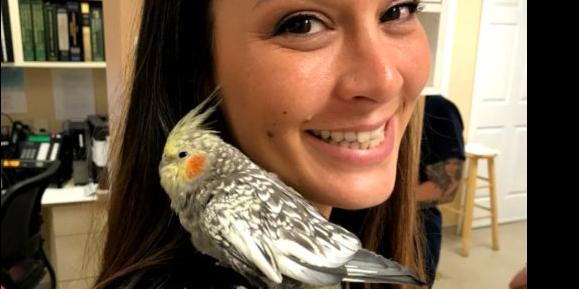
Grooming For Birds
If you have a pet bird, you may have questioned whether or not you need to get your bird’s nails, beak, and feathers trimmed. And if these services are needed, how often are they performed and who does them? We will go into each topic now but please consult your avian/exotic veterinarian with any specific questions you have.
Birds should have various sized perches made of different types of material- wooden, cement, sandpaper, etc. These materials help to keep the nails of a bird worn down and the skin on the bottom of the feet healthy. However, some birds will still need occasional nail trims to take off the sharp points or to keep them short for handling purposes. Small species of birds usually have clear nails where the quick is easily seen within the curvature of the nail. Human nail clippers or small cat nail clippers can be used to take off the clear part of the nail. If your bird has black nails or it’s hard to tell where the quick ends, you will want to bring your bird to the vet for nail trims with a dremel. This is a tool that safely wears down and shapes the nails and we’ll have clotting powder to use in case the quick is compromised. How often nail trims are performed depends on the bird and how quickly their nails grow-usually every other month or once a quarter is sufficient.
A bird’s beak should never need to be trimmed, not without there being an underlying husbandry or medical problem. Birds should use their abrasive perches to rub their beak to groom them and keep them worn down. Usually this is done during the eating process so make sure the perch near your bird’s food bowl is an abrasive one. However, there are many husbandry issues and medical diseases that can cause a bird’s beak to over grow, become flaky, or even break. A bird that eats a diet of mainly seeds is very predisposed to beak issues. This is because seeds are extremely high in fat and low in Vitamin A. This vitamin is essential for skin, beak, and nail health and without it the beak will be extremely flaky and brittle. Illnesses such as liver disease, infections, and even trauma are medical reasons for an overgrown or abnormal beak. Your veterinarian will need to do a full physical exam, husbandry/diet review, blood work, and possibly infectious disease testing to determine the underlying cause for an abnormal beak. Once the cause is determined, this will need to be fixed in order to promote healing. A dremel will be used to shape, shorten, and smooth out the beak to appropriate length and appearance. But without fixing the underlying problem, the beak will continue to grow abnormally. How often a beak needs trimming depends on the growth rate and underlying cause.
Wing trims are always a personal preference of the owner- there is no exact medical benefit of trimming your bird’s wings. The main benefit is to prevent the bird from being able to fly up into the air and out of the house/yard. If your bird is allowed to spend time outside, trimming the wing feathers should be highly considered to prevent escape and losing your bird. The trimming only prevents them from getting lift into the air; they will still be able to flutter around a bit. So if you have dogs or other animals in the house that your bird should be able to escape from, they may need to keep their flight feathers. Keeping your bird fully flighted allows a little bit more exercise but they’ll still be able to flap around even with trimmed feathers. Wing trims are usually needed twice a year and your avian veterinarian will be able to perform this safely and efficiently.

